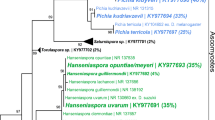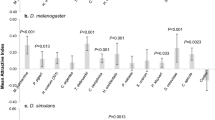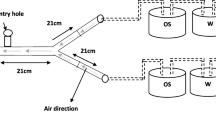Abstract
We investigated two strains of uricase (+) Enterobacter agglomerans, one isolated from the apple maggot fly (AMF) and one from the Mexican fruit fly (MFF), for 1) attractiveness to MFF, and 2) production of attractive chemicals. Regarding chemicals demonstrated attractive to the MFF, the MFF bacterial strain produced more 2,5-dimethylpyrazine, 2-phenylethanol, and indole than the AMF strain, whereas the AMF, but not the MFF strain, produced 3-hydroxybutanone. Cell types that predominated in plated subcultures varied from batch to batch resulting in variation in volatiles production, especially by the AMF strain where indole was sometimes a major component of the odor and at other times not detectable. Despite the greater production of attractive chemicals by the MFF strain, the AMF strain was consistently more attractive and the MFF strain was not different from uninoculated control plates. Statistical analyses indicated negative correlations of attractiveness with production of indole, 2,5-dimethylpyrazine, and 2-phenylethanol, and positive correlation with 3-hydroxybutanone. Results support previous findings with the Mexican fruit fly that showed combinations of attractive chemicals sometimes are not attractive.
Similar content being viewed by others
REFERENCES
ABACUS CONCEPTS. 1989. SuperANOVA. Abacus Concepts, Inc., Berkeley, CA.
ALLEN, T. C. and RIKER, A. J. 1932. A rot of apple fruit caused by Phytomonas melophthora., N. sp., following invasion by the apple maggot. Phytopathology.22:557–571.
BARTELT, R. J. 1997. Calibration of a commercial solid-phase microextraction device for measuring headspace concentrations of organic volatiles. Anal. Chem. 69:364–372.
BOUSH, G. M. and MATSUMURA, F. 1967. Insecticidal degradation by Pseudomonas melophthora., the bacterial symbiote of the apple maggot. J. Econ. Entomol. 60:918–920.
BRENNER, D. J. 1984. Family I. Enterobacteriaceae Rahn 1937, pp. 408–516, inN. R. Krieg and J. G. Holt (eds.). Bergey'sManual of Systematic Bacteriology,Vol. 1.Williams andWilkins, Baltimore, MD.
DEMILO, A. B., LEE, C.-J., MORENO, D. S., and MARTINEZ, A. J. 1996. Identification of volatiles derived from Citrobacter freundiifermentation of a trypticase soy broth. J. Agric. Food Chem. 44:607–612.
DREW, R. A. I., COURTICE, A. C., and TEAKLE, D. S. 1983. Bacteria as a natural source of food for fruit flies (Diptera: Tephritidae). Oecologia.60:279–284.
DREW, R. A. I. and FAY, H. A. C. 1988. Comparison of the roles of ammonia and bacteria in the attraction of Dacus tryoni.(Froggatt) (Queensland fruit fly) to proteinaceous suspensions. J. Plant Prot. Trop. 5:127–130.
DREW, R. A. I. and LLOYD, A. C. 1989. Bacteria associated with fruit flies and their host plants, pp. 131–140, inA. S. Robinson and G. Hooper (eds.). Fruit Flies, Their Biology, Natural Enemies and Control, Vol. 3A. Elsevier, New York.
EPSKY, N. D., HEATH, R. R., DUEBEN, B. D., LAUZON, C. R., PROVEAUX, A. T., and MACCOLLOM, G. B. 1998. Attraction of 3-methylbutanol and ammonia identified from Enterobacter agglomeransto Anastrepha suspensa . J. Chem. Ecol. 24:1867–1880.
FITT, G. P. and O'BRIEN, R.W. 1985. Bacteria associated with four species of Dacus.(Diptera: Tephritidae) and their role in the nutrition of the larvae. Oecologia.67:447–454.
GOW, P. L. 1954. Proteinaceous bait for the Oriental fruit fly. J. Econ. Entomol. 47:153–160.
HAGEN, K. S. 1966. Dependence of the olive fly, Dacus oleae., larvae on symbiosis with Pseudomonas savastanoi.for the utilization of olive. Nature.209:423–424.
HOWARD, D. J. 1989. The symbionts of Rhagoletis., pp. 121–129, inA. S. Robinson and G. Hooper (eds.). Fruit Flies, Their Biology, Natural Enemies and Control, Vol. 3A. Elsevier, New York.
HUSTON, F. 1972. Symbiotic association of bacteria with the apple maggot, Rhagoletis pomonella.(Walsh) (Diptera: Tephritidae). MS thesis, Acadia University, Wolfville, NS, Canada.
JANG, E. B. and NISHIJIMA, K. A. 1990. Identification and attractancy of bacteria associated with Dacus dorsalis.(Diptera: Tephritidae). Environ. Entomol. 19:1726–1751.
KUZINA, L. V., PELOQUIN, J. J., VACEK, D. C., and MILLER, T. A. 2001. Isolation and identification of bacteria associated with adult laboratory Mexican fruit flies, Anastrepha ludens.(Diptera: Tephritidae). Curr. Microbiol. 42:290–294.
LAUZON, C. R. 1988. The role of a newly described microorganism in the life cycle of Rhagoletis pomonella, inProceedings of the 18th International Congress Entomology.,Vancouver, BC, 7 July, 1988.
LAUZON, C. R. 1991. Microbial ecology of a fruit fly pest, Rhagoletis pomonella.(Walsh) (Diptera: Tephritidae). PhD dissertation, University of Vermont, Burlington.
LAUZON, C. R., SJOGREN, R. E., and PROKOPY, R. J. 2000. Enzymatic capabilities of bacteria associated with apple maggot flies: A postulated role in attraction. J. Chem. Ecol. 26:953–969.
LAUZON, C. R., SJOGREN, R. E., WRIGHT, S. E., and PROKOPY, R. J. 1998. Attraction of Rhagoletis pomonella(Diptera: Tephritidae) flies to odor of bacteria: Apparent confinement to specialized members of Enterobacteriaceae. Environ. Entomol. 27:853–857.
LEE, C.-J., DEMILO, A. B., MORENO, D. S., and MARTINEZ, A. J. 1995. Analyses of the volatile components of a bacterial fermentation that is attractive to the Mexican fruit fly, Anastrepha ludens. J. Agric. Food Chem. 43:1348–1351.
MACCOLLOM, G. B., LAUZON, C. R., PAYNE, E. B., and CURRIER, W.W. 1994. Apple maggot (Diptera: Tephritidae) trap enhancement with washed bacterial cells. Environ. Entomol. 23:354–359.
MACCOLLOM, G. B., LAUZON, C. R., WEIRES, R. W., JR., and RUTKOWSKI, A. A. 1992. Attraction of adult apple maggot (Diptera: Tephritidae) to microbial isolates. J. Econ. Entomol. 85:83–87.
MARCHINI, D., ROSETTO, M., DALLAI, R., and MARRI, L. 2002. Bacteria associated with the oesophageal bulb of the Medfly Ceratitis capitata.(Diptera: Tephritidae). Curr. Microbiol. 44:120–124.
MARTINEZ, A. J., ROBACKER, D. C., GARCIA, J. A., and ESAU, K. L. 1994. Laboratory and field olfactory attraction of the Mexican fruit fly (Diptera: Tephritidae) to metabolites of bacterial species. Fla. Entomol. 77:117–126.
PETRI, L. 1910. Untersuchung uber die Darmbakterien der Olivenfliege. Zentralbl. Bakteriol., Parasitenkd. Infektionskr. Hyg. 26:357–367.
PROKOPY, R. J., COOLEY, S. S., GALARZA, L., BERGWEILER, C., and LAUZON, C. R. 1993. Bird droppings compete with bait sprays for Rhagoletis pomonella.(Walsh) flies (Diptera: Tephritidae). Can. Entomol. 125:413–422.
ROBACKER, D. C. and BARTELT, R. J. 1997. Chemicals attractive to Mexican fruit fly from Klebsiella pneumoniae.and Citrobacter freundii.cultures sampled by solid-phase microextraction. J. Chem. Ecol. 23:2897–2915.
ROBACKER, D. C., DEMILO, A. B., and VOADEN, D. J. 1997. Mexican fruit fly attractants: Effects of 1-pyrroline and other amines on attractiveness of a mixture of ammonia, methylamine, and putrescine. J. Chem. Ecol. 23:1263–1280.
ROBACKER, D. C. and FLATH, R. A. 1995. Attractants from Staphylococcus aureus.cultures for the Mexican fruit fly, Anastrepha ludens. J. Chem. Ecol. 21:1861–1874.
ROBACKER, D. C. and GARCIA, J. A. 1993. Effects of age, time of day, feeding history, and gamma irradiation on attraction of Mexican fruit flies (Diptera: Tephritidae), to bacterial odor in laboratory experiments. Environ. Entomol. 22:1367–1374.
ROBACKER, D. C., GARCIA, J. A., and BARTELT, R. J. 2000. Volatiles from duck feces attractive to Mexican fruit fly. J. Chem. Ecol. 26:1849–1867.
ROBACKER, D. C., GARCIA, J. A., MARTINEZ, A. J., and KAUFMAN, M. G. 1991. Strain of Staphylococcusattractive to laboratory strain Anastrepha ludens.(Diptera: Tephritidae). Ann. Entomol. Soc. Am. 84:555–559.
ROBACKER, D. C. and HEATH, R. R. 1997. Decreased attraction of Anastrepha ludens.to combinations of two types of synthetic lures in a citrus orchard. J. Chem. Ecol. 23:1253–1262.
ROBACKER, D. C. and LAUZON, C. R. 2002. Purine metabolizing capability of Enterobacter agglomeransaffects volatiles production and attractiveness to Mexican fruit fly. J. Chem. Ecol. 28:1549–1563.
ROBACKER, D. C., MARTINEZ, A. J., GARCIA, J. A., and BARTELT, R. J. 1998. Volatiles attractive to the Mexican fruit fly (Diptera: Tephritidae) from eleven bacteria taxa. Fla. Entomol. 81:497–508.
ROBACKER, D. C. and MORENO, D. S. 1995. Protein feeding attenuates attraction of Mexican fruit flies (Diptera: Tephritidae) to volatile bacterial metabolites. Fla. Entomol.78:62–69.
ROBACKER, D. C., MORENO, D. S., and DEMILO, A. B. 1996. Attractiveness to Mexican fruit flies of combinations of acetic acid with ammonium/amino attractants with emphasis on effects of hunger. J. Chem. Ecol. 22:499–511.
ROBACKER, D. C. and WARFIELD, W. C. 1993. Attraction of both sexes ofMexican fruit fly, Anastrepha ludens., to a mixture of ammonia, methylamine, and putrescine. J. Chem. Ecol. 19:2999–3016.
SNEDECOR, G. W. and COCHRAN, W. G. 1967. Statistical Methods. The Iowa State University Press, Ames, IO.
YU, K., HAMILTON-KEMP, T. R., ARCHBOLD, D. D., COLLINS, R. W., and NEWMAN, M. C. 2000. Volatile compounds from Escherichia coli.O157:H7 and their absorption by strawberry fruit. J. Agric. Food Chem. 48:413–417.
Author information
Authors and Affiliations
Rights and permissions
About this article
Cite this article
Robacker, D.C., Lauzon, C.R. & He, X. Volatiles Production and Attractiveness to the Mexican Fruit Fly of Enterobacter agglomerans Isolated from Apple Maggot and Mexican Fruit Flies. J Chem Ecol 30, 1329–1347 (2004). https://doi.org/10.1023/B:JOEC.0000037743.98703.43
Issue Date:
DOI: https://doi.org/10.1023/B:JOEC.0000037743.98703.43




